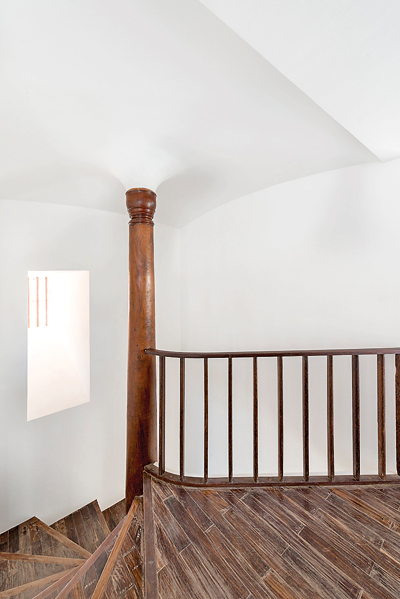Staircases that bring theatre to architecture
View(s):
The staircase at the Ena de Silva home. Images courtesy Sebastian Posingis
David Robson’s new book is devoted to the staircase designs of master architect Geoffrey Bawa and demonstrates with over 30 examples how these formed an important partof his oeuvre. In so doing it identifies a number of key influences that contributed to their development: staircases of the Italian Renaissance that he studied whilst living in Rome in 1956; the staircases of German Baroque architect Balthasar Neumann about whom he wrote his thesis in 1957; and last but not least the staircases of ancient Sri Lanka.
Ruskin advised: “Don’t look at architecture, watch it!” This was something that Bawa did throughout his life. Robson demonstrates how he was able to borrow ideas from the past and transform them into something new. Thus the entrance sequence of the Bentota Beach Hotel (now demolished) proceeds from a darkened portecochère to a richly decorated batik ceiling by Ena de Silva, echoing the staircase in Balthasar Neumann’s Würzburg Residenz which rises in similar fashion towards Tiepolo’s painted ceiling.
My own first assignment when I joined Geoffrey Bawa’s office in 1977 after completing my architectural studies in London, was to draw up his design for the corkscrew staircase in the Lydia Duchini House in Bentota, which appears in the cover of the book. This introduced me to Bawa’s unique way of developing a design in which function, structure, wit and aesthetics all played a part.
The book describes the extent to which Bawa enjoyed designing staircases and demonstrates that no two of his staircase designs were the same. This latter fact is revealed in the vast campus of the University of Ruhunu where it seems that every single staircase is unique. He was a master of architectural scenography and regarded a staircase as being potentially the most theatrical element of a building, as when he collaborated with Laki Senanayake to create a staircase in the form of a battle scene for the Lighthouse Hotel. A key element of Bawa’s design philosophy was the desire to give pleasure, something which he achieved effortlessly in his curving staircases for the children in St. Bridget’s Montessori (now partly demolished).

Fun staircase: At St. Bridget’s Convent Montessori
All of this is revealed in Robson’s clear and jargon-free text, illustrated with the beautiful photographs of Sebastian Posingis. Posingis is a Sri-Lanka-based photographer who grew up here and has provided photographs for “The New Sri Lankan House” (2015), “In Search of Bawa” (2016)”, and “ The Island from Above” ((2015).
Unfortunately a book of this scope cannot be all-embracing and it is regrettable that it does not include some of the many staircases in India that Bawa admired, such as those in the Amber Fort in Rajasthan, and the famous stepped wells of the Ahmadabad District.
Bawa also produced remarkable designs for lighting fittings that were manufactured by Belek Baas in a workshop at Lunuganga as well as designs for furniture and even ashtrays for his hotels. These could provide material for another book.
David Robson studied architecture in the Bartlett School of London’s University College. Between 1969 and 1971 he was a senior lecturer in the newly formed School of Architecture in the University of Ceylon Colombo. Between 1978 and 1982 he worked as a special adviser on Prime Minister Premadasa’s Hundred Thousand Houses programme and was responsible for the design of electoral housing schemes, model villages and the masterplan of Rampokunagama New Town.
In 1997 Bawa recruited David to help him write a monograph on his work. Unfortunately, Bawa suffered a debilitating stroke in 1998 and the book was eventually published without his direct involvement by Thames and Hudson in 2002. In 2004 David joined Amila de Mel to curate a major retrospective exhibition of Bawa’s work in the German Architecture Museum in Frankfurt. David has written several other books on Bawa.It is no exaggeration, therefore, to suggest that David Robson’s writings have made an important contribution to the development of an architectural culture in Sri Lanka.
| Book facts | |
| BAWA STAIRCASES by David Robson with photographs by Sebastian Posingis; Talisman; 2011 Price: Rs. 5,100 Reviewed by C. Anjalendran
|


